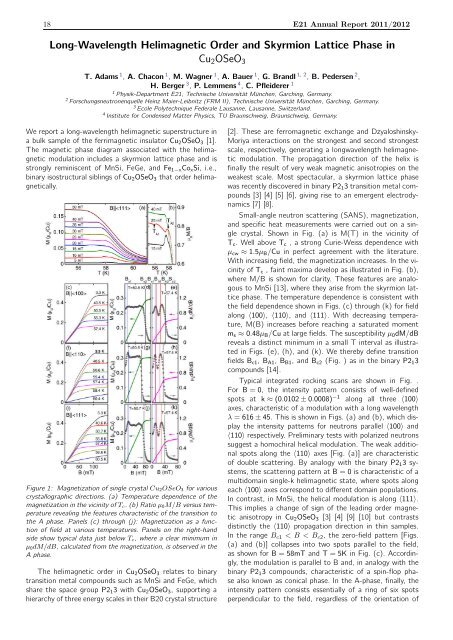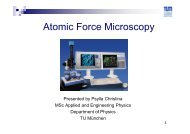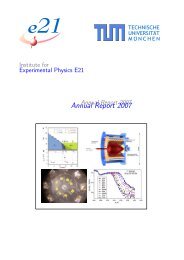Annual Report 2011 / 2012 - E21 - Technische Universität München
Annual Report 2011 / 2012 - E21 - Technische Universität München
Annual Report 2011 / 2012 - E21 - Technische Universität München
Create successful ePaper yourself
Turn your PDF publications into a flip-book with our unique Google optimized e-Paper software.
18 <strong>E21</strong> <strong>Annual</strong> <strong>Report</strong> <strong>2011</strong>/<strong>2012</strong><br />
Long-Wavelength Helimagnetic Order and Skyrmion Lattice Phase in<br />
Cu 2 OSeO 3<br />
T. Adams 1 , A. Chacon 1 , M. Wagner 1 , A. Bauer 1 , G. Brandl 1, 2 , B. Pedersen 2 ,<br />
H. Berger 3 , P. Lemmens 4 , C. Pfleiderer 1<br />
1 Physik-Department <strong>E21</strong>, <strong>Technische</strong> Universität München, Garching, Germany.<br />
2 Forschungsneutronenquelle Heinz Maier-Leibnitz (FRM II), <strong>Technische</strong> Universität München, Garching, Germany.<br />
3 Ecole Polytechnique Federale Lausanne, Lausanne, Switzerland.<br />
4 Institute for Condensed Matter Physics, TU Braunschweig, Braunschweig, Germany.<br />
We report a long-wavelength helimagnetic superstructure in<br />
a bulk sample of the ferrimagnetic insulator Cu 2 OSeO 3 [1].<br />
The magnetic phase diagram associated with the helimagnetic<br />
modulation includes a skyrmion lattice phase and is<br />
strongly reminiscent of MnSi, FeGe, and Fe 1−x Co x Si, i.e.,<br />
binary isostructural siblings of Cu 2 OSeO 3 that order helimagnetically.<br />
Figure 1: Magnetization of single crystal Cu 2OSeO 3 for various<br />
crystallographic directions. (a) Temperature dependence of the<br />
magnetization in the vicinity of T c. (b) Ratio µ 0M/B versus temperature<br />
revealing the features characteristic of the transition to<br />
the A phase. Panels (c) through (j): Magnetization as a function<br />
of field at various temperatures. Panels on the right-hand<br />
side show typical data just below T c, where a clear minimum in<br />
µ 0dM/dB, calculated from the magnetization, is observed in the<br />
A phase.<br />
The helimagnetic order in Cu 2 OSeO 3 relates to binary<br />
transition metal compounds such as MnSi and FeGe, which<br />
share the space group P2 1 3 with Cu 2 OSeO 3 , supporting a<br />
hierarchy of three energy scales in their B20 crystal structure<br />
[2]. These are ferromagnetic exchange and Dzyaloshinsky-<br />
Moriya interactions on the strongest and second strongest<br />
scale, respectively, generating a longwavelength helimagnetic<br />
modulation. The propagation direction of the helix is<br />
finally the result of very weak magnetic anisotropies on the<br />
weakest scale. Most spectacular, a skyrmion lattice phase<br />
was recently discovered in binary P2 1 3 transition metal compounds<br />
[3] [4] [5] [6], giving rise to an emergent electrodynamics<br />
[7] [8].<br />
Small-angle neutron scattering (SANS), magnetization,<br />
and specific heat measurements were carried out on a single<br />
crystal. Shown in Fig. (a) is M(T) in the vicinity of<br />
T c . Well above T c , a strong Curie-Weiss dependence with<br />
µ cw ≈ 1.5µ B /Cu in perfect agreement with the literature.<br />
With increasing field, the magnetization increases. In the vicinity<br />
of T c , faint maxima develop as illustrated in Fig. (b),<br />
where M/B is shown for clarity. These features are analogous<br />
to MnSi [13], where they arise from the skyrmion lattice<br />
phase. The temperature dependence is consistent with<br />
the field dependence shown in Figs. (c) through (k) for field<br />
along 〈100〉, 〈110〉, and 〈111〉. With decreasing temperature,<br />
M(B) increases before reaching a saturated moment<br />
m s ≈ 0.48µ B /Cu at large fields. The susceptibility µ 0 dM/dB<br />
reveals a distinct minimum in a small T interval as illustrated<br />
in Figs. (e), (h), and (k). We thereby define transition<br />
fields B c1 , B A1 , B B1 , and B c2 (Fig. ) as in the binary P2 1 3<br />
compounds [14].<br />
Typical integrated rocking scans are shown in Fig. .<br />
For B = 0, the intensity pattern consists of well-defined<br />
spots at k ≈ (0.0102±0.0008) −1 along all three 〈100〉<br />
axes, characteristic of a modulation with a long wavelength<br />
λ = 616±45. This is shown in Figs. (a) and (b), which display<br />
the intensity patterns for neutrons parallel 〈100〉 and<br />
〈110〉 respectively. Preliminary tests with polarized neutrons<br />
suggest a homochiral helical modulation. The weak additional<br />
spots along the 〈110〉 axes [Fig. (a)] are characteristic<br />
of double scattering. By analogy with the binary P2 1 3 systems,<br />
the scattering pattern at B = 0 is characteristic of a<br />
multidomain single-k helimagnetic state, where spots along<br />
each 〈100〉 axes correspond to different domain populations.<br />
In contrast, in MnSi, the helical modulation is along 〈111〉.<br />
This implies a change of sign of the leading order magnetic<br />
anisotropy in Cu 2 OSeO 3 [3] [4] [9] [10] but contrasts<br />
distinctly the 〈110〉 propagation direction in thin samples.<br />
In the range B c1 < B < B c2 , the zero-field pattern [Figs.<br />
(a) and (b)] collapses into two spots parallel to the field,<br />
as shown for B = 58mT and T = 5K in Fig. (c). Accordingly,<br />
the modulation is parallel to B and, in analogy with the<br />
binary P2 1 3 compounds, characteristic of a spin-flop phase<br />
also known as conical phase. In the A-phase, finally, the<br />
intensity pattern consists essentially of a ring of six spots<br />
perpendicular to the field, regardless of the orientation of




